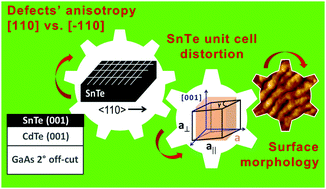Unit cell distortion and surface morphology diversification in a SnTe/CdTe(001) topological crystalline insulator heterostructure: influence of defect azimuthal distribution†
Abstract
Challenges and opportunities arising from molecular beam epitaxial growth of topological crystalline insulator heterostructures composed of a rock-salt SnTe(001) layer of varying thickness (from 80 nm to 1000 nm) and a zinc blende 4 μm thick CdTe(001) buffer layer grown on a commercial GaAs(001) substrate with 2° off-cut toward the [100] direction were studied with a focus on crystal lattice strain, unit cell symmetry breaking and surface quality. The results indicate that the CdTe buffer is almost fully relaxed whereas in SnTe layers slight anisotropic relaxation is observed that varies from 86.2% to 98.3% with the layer thickness increasing. The relaxation process involves formation of misfit dislocations, mainly of Lomer-type (consisting of two associated 60° dislocations), both at CdTe/GaAs and SnTe/CdTe interfaces. Azimuthal spatial distribution of defects is anisotropic due to a disparity of 60° dislocation mobility toward orthogonal [−110] and [110] crystallographic directions. This results in a monoclinic distortion of the SnTe unit cell, as observed especially in the layers grown without additional Te molecular flux. A reflections selection method is proposed to measure such crystal deformations. Qualitatively new morphology of the SnTe surface of a reduced symmetry with nanoripple-like structures oriented close to the 〈100〉 (or, rarely, to 〈120〉) crystallographic in-plane direction is observed. The possible mechanism of their formation is dislocation-driven while their extended shape and predominant crystalline orientation may be influenced by the anisotropy of defect azimuthal distribution. Due to the magnitude of measured lattice strain (∼10−3) the monoclinic distortion in SnTe(001) layers is expected to be large enough to affect their physical properties, e.g., offering the way of controlling the crystal-symmetry-protected surface states (deformation-induced opening of the energy gap in the spectrum of metallic topological surface states). Thus, it may serve as an additional degree of freedom in designing topological spintronic devices.



 Please wait while we load your content...
Please wait while we load your content...